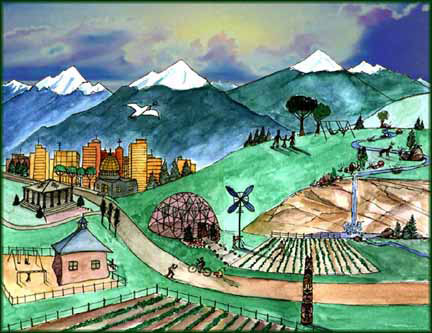Sustainable Culture
This original text is circa 1996, for the first website of sustainability.org.
It was crafted by the team led by Ben Lipman (now aka VARADAAN).
This text and the website where it appeared was created before exposure to the Spiral Dynamics model. Thus there were at this time, only 12 sectors and 5 levels of scale.
Ultimately, Sustainable Culture is about Holistic Health for the individual and for at least one planet.
The way we get there is by examining our own health on all levels, including the spiritual, physical and mental aspects of being. This is not rocket science, but at the same time it is basic and important. Many have gone before. A healthy person learns most readily, and thus cultural evolution is most likely, when a field of high health is maintained for that individual. The pattern of health for the individual is very similar to the pattern of health for a group. So, to develop rapid cultural evolution, say for a group intending to model a less impactful, more satisfying lifestyle, a pattern of health is essential. If we use the now familiar precept that ultimately, everything is just an energy pattern, then working to hold certain patterns will tend to produce desired results, once the models are known.
Many people are aware that consensus decision making, when attempted skillfully and under the right conditions, can be the most effective decision-making strategy when long term results are important. Consensus eliminates the polarized minority and moves the whole group forward together as one unit. It is more efficient, when the group is willing and able.
Studying patterns is a very powerful conceptual strategy, as demonstrated by the organic agricultural practice of Permaculture, the use of language, and in modern times, object oriented computer programming. Studying the patterns of group dynamics is central to the examination of cooperative lifestyles, and once applied to complex living systems, pattern-study becomes essential to understanding the mechanisms of sustainability, the only known wild examples of which occurred through extended evolutionary processes.
Healthy systems permit a particular kind of evolutionary process, which in conjunction with one working definition of sustainability, creates a synergistic relationship:
Sustainability is the condition where the opportunity for evolution without discontinuity is preserved.
This is a hermeneutic condition where the the evolutionary journey is secured by what must be an adaptive process, or it will not continue without sudden or catastrophic change. Sustainability is not a static condition, but it is a condition of at least marginal health. A challenge facing humankind at the moment is not knowing how healthy our global system needs to be in order to assure future generations that the whole system is "sustainable." Many of the younger generations are not convinced that this most awesome mantle of stewardship is being shouldered responsibly. A feasible response to very real concerns along these lines, coming from a great diversity of quarters these days, is developing a map for a pattern of sustainable culture— a praxis for a holistic form of stewardship, one that is inextricably woven with human culture, so that civilization as we know it can move incrementally toward an evolutionarily more advanced pattern of thought, lifestyle and being, as we find the wherewithal to consciously direct it there.
Fortunately, a very substantial amount of work has already been done. At the Solstice Institute, building on the work of others, we have identified twelve major theme areas, which taken together and in relation to each other, comprise a comprehensive map of Sustainable Culture. These areas must be considered at the various levels of scale and stages of evolution of social organization, beginnning with the individual. The seat of consciousness and the manner in which it manifests is all important. The whole is, ultimately, nothing more than the sum of the parts. Curiously, for many people, the only way to stay whole and complete in intention is to find community. So once again there is this self-reflexive property: The group holds the individuals.
Perhaps the only way Humanity will grasp and fully manifest health at all levels- from individual to world - will be when all sentient beings come to understand the synergistic relationships among all that is. . . It is, ultimately, after all, just energy interacting with itself, right? So, consider the Buddhist objective: May all sentient beings become enlightened!







